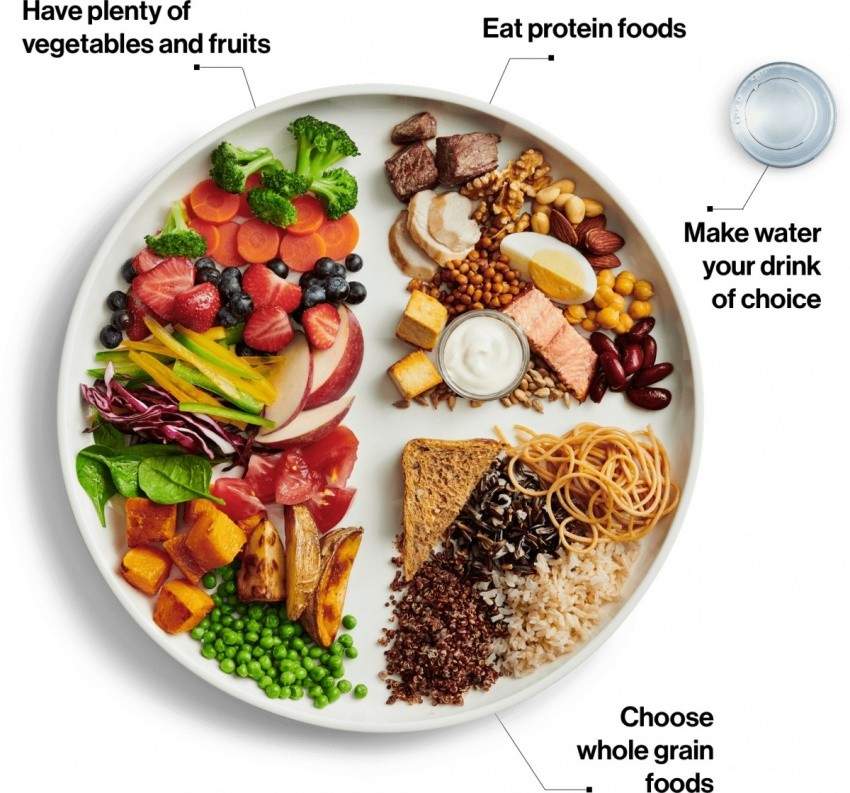Health Canada released its latest update to Canada’s Food Guide on Tuesday, 12 years after the previous version was released. At the press conference, health minister Ginette Petitpas-Taylor joked that the iPhone hadn’t been invented yet when the last food guide came out.
Though not a perfect document, early feedback has been overwhelmingly positive. Here are some of the biggest improvements to Canada’s Food Guide, plus some areas that still need a bit of work.
What the New Food Guide does Well
Goodbye rainbow, hello plate
The most obvious change can be found on the front of the food guide. Instead of a rainbow graphic depicting the four food groups, Canadians are now greeted by a colourful plate featuring vegetables and fruit, protein foods, whole grain foods, and a glass of water, which we’re told should be our “drink of choice.”

The protein foods section of the plate shows a variety of choices, including beef (ahem), dairy (ahem), and various plant-based proteins, like legumes, nuts, and tofu.
The food guide has also done away with recommended serving sizes and number of servings of different types of food per day. I think this is a reflection that one size doesn’t fit all when it comes to nutrition, and that many eating patterns can be health-promoting.
A focus on how we eat, versus what we eat
In addition to the plate, Canada’s Food Guide includes seven recommendations under Eating Habits:
- Be mindful of your eating habits
- Cook more often
- Enjoy your food
- Eat meals with others
- Use food labels
- Limit foods high in sodium, sugars, or saturated fat
- Be aware of food marketing
This section of the food guide has received the most praise, as it shows a shift away from what and how much we eat toward how and why we eat, echoing the Dietary Guidelines for the Brazilian Population that also received an overwhelmingly positive response when they were released in 2014.
More than just a handout
While the Canada’s Food Guide Snapshot will likely be what will pop up in doctor’s offices near you, Health Canada has developed a host of resources on its website. Beyond details on the plate and healthy eating recommendations, the website includes recipes, healthy eating tips including meal planning and cooking, as well as more specific recommendations for different life-stages and environments. Petitpas-Taylor stressed that Canada’s Food Guide will be constantly updated instead of the static document of versions past. In fact, there is a plan for another release later this year that provides more specific recommendations on amounts and types of foods.
Where the New Food Guide Can Improve
More flexibility and cultural sensitivity
Although the plate image and lack of recommended serving sizes and amounts is far less rigid than previous editions of the food guide, there are also parts that can be interpreted as being less flexible. While the beef and dairy industries have been up in arms about being grouped together with plant-based proteins, I’m curious how companies will feel about “grain products” being turned into “whole grains.” Despite the lack of recommended serving sizes and amounts, at the press conference, Petitpas-Taylor highlighted that Canadians should aim to eat foods in the proportions indicated on the plate: filling half your plate with vegetables and fruit, a quarter with protein foods, and a quarter with whole grains.

As a person of Chinese background, I also hope that future updates will be more culturally-sensitive, not only showing token pictures of “ethnic” foods, but also recognizing that many cultures eat foods served family-style, and that a plate may not be an helpful reflection of how people eat.
Mindful eating
For me--someone who literally wrote a book on mindful eating--the recommendation to “be mindful of your eating habits” actually sent up red flags. “Mindful eating” is often misconstrued as “careful eating,” like “I’m being mindful of my portion sizes;” when really, it’s about being present in the eating experience without judgment. While the more detailed section on that recommendation is more in alignment with what mindful eating actually is, I think that the “be mindful” wording and the fact that it’s being presented in a food guide takes away from the spirit of non-judgment. “Practice mindful eating” or “practice mindful eating principles” may have been a more appropriate and neutral choice.
Make resources more available and accessible
While Canada’s Food Guide is a huge improvement on previous editions, sadly, a lot of the “good stuff” is only on the website, which means a certain level of literacy, access to a computer, and time to review the information is necessary in order to get all that the food guide has to offer. Even though most Canadians won’t be using the food guide every day (nor is that how the food guide is intended to be used), as the second-most downloaded government document (behind tax forms), Canada’s Food Guide will have far-reaching impacts on our food environment and how we think about food, nutrition, and health. I hope the hard work that has gone into this document doesn’t get lost in oversimplification.













